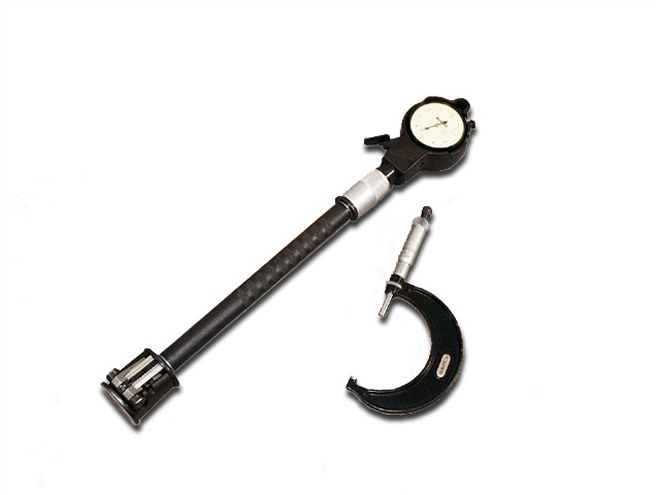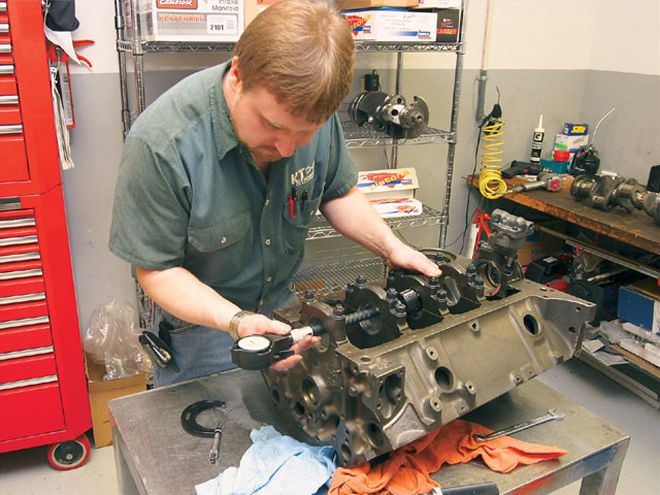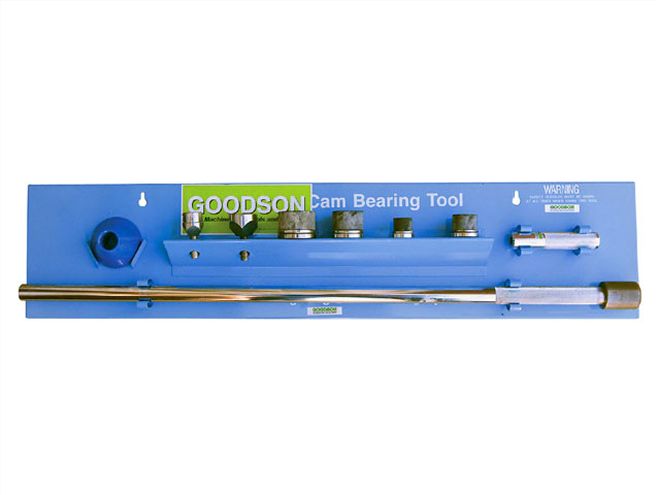
 Engine teardown and assembly is something you can do if you have the right background, but you will need a few specific tools to make your life easier.
Engine teardown and assembly is something you can do if you have the right background, but you will need a few specific tools to make your life easier.
One of the greatest things about stock car racing is there is no magic involved. Some may say there is, but it's usually just the winners not wanting to divulge their secrets. No, when you get right down to it, the only magic in racing is the ability of the driver to feel what his car is doing a split-second faster than anyone else on the track. The rest of it-the car-is just good ol' mechanical engineering, thermodynamics, and adhesion. There is nothing anyone else can do with a car that you and I, given the time, education, and inclination, cannot do just as well ourselves.
Many racers take this truth to heart when they attempt their own engine teardown and assembly. The equipment necessary for block and head machining is cost prohibitive and should be left to the engine shops, but there is no rule that says you can't do much of the rest yourself. If this describes your situation, then here's a breakdown of some of the most valuable tools any engine assembler can use.

Dial Bore Gauge and Crank Journal Micrometer
When you get right to the crux of the matter, the difference between a race engine and an OEM street engine is in the blueprinting. A qualified engine builder can yank the engine out of your Sunday driver, tear it apart, put it back together using the same parts, and find horsepower. He can do this because he's a stickler for making every piece fit perfectly. A good engine builder spends more time making sure all his clearances are right-not too big and not too small-than he does turning bolts. That's why his measurement tools are more important than his wrenches.
Two of the most important measurement tools you can own are a dial bore gauge and a crank micrometer. Used correctly, a dial bore gauge is one of the best instruments for checking size, straightness and taper of the cylinder, cam and crank bores, as well as measuring the big end of the rod. Used in conjunction with the dial bore gauge, the crank micrometer reads the size of the crank, cam, and rod journals. These measurements are all critical because they help maintain proper clearances on all your bearing surfaces-the heart of an engine when it comes to proper oiling and reduction of parasitic losses.

Cam Bearing InstallerThe cam bearing installer is one of the most expensive tools on this list. But like the dial bore gauge, another expensive tool, it is absolutely necessary. Without this tool, there is no way to correctly install the cam bearings in all five journals without damaging them. Getting them out without this tool also isn't fun. The tool pictured from Goodson is a universal set that will work with just about any pushrod engine you can find, but both Goodson and Powerhouse Products sell installers for specific bore sizes that cost less. Another option is to have your engine builder install the bearings after he completes the machine work on your block. Still, if you plan to spend a lot of time working with your engines, this is a tool you will want to have.
Ring Filer Death, taxes, and gapping rings. Those are the immutable laws for engine builders. Rings have to be gapped to specific tolerances (provided by the manufacturer) so that they close up and properly seal off the cylinder bore when the engine heats up. The ring filer pictured is a top-of-the-line electric model with a motor that does most of the work for you, but there are also cheaper, hand-cranked models that do the job just as well.
Height Micrometer If you are installing your own valves and springs, the height mic is the quickest and most accurate tool for checking the installed height of the valvespring. You simply install the mic in place of a valvespring and then run it up until it has seated the valve, locks, and retainer. Spring height must be consistent across all your like valves (intake or exhaust) for you to have consistent spring pressures. If it isn't, your machinist probably cut a seat too deep. Knowing your spring height also helps you determine if you have enough valve travel for your cam.
Ring Compressor There are several versions of piston ring compressors, and they vary greatly in price and ease of use. You need a ring compressor to hold the piston rings tight in the ring grooves for the piston to fit in the cylinder bore. Generally, the tapered-sleeve-style compressors (right) are quicker and simpler to use. You just slide the rod and piston through the top of the sleeve, place the lot of it over the cylinder bore, and press the piston on in. Tapered ring compressors are also the best at getting a ringed piston into the bore without causing ring damage or breakage.
Connecting Rod Vise During the process of sizing your rods and installing the bearings, you will have your rods apart two or three times. A rod vise holds a rod securely so that you can properly torque the rod bolts and then get the rod cap off again without harming either the rod or the bearing.
Telescoping Gauges If you can't swing the cost of a dial bore gauge (depending on quality, they vary anywhere from $150 to $1,000), you can get by with a pair of dial calipers and a set of telescoping gauges. The gauges find the maximum inside diameter of an object and lock in place. You can use your dial calipers to measure the gauge to get your ID measurement. They're good for tight areas where it is difficult to get a dial caliper to fit.
Feeler Gauge This tool is used for those areas where the clearances are simply too tight to use a micrometer. A feeler gauge is most often used to determine end gap on your piston rings (slide the ring in the cylinder bore without the piston and insert the feeler into the gap) and for setting valve lash. Each of the feelers is marked with a specific thickness.
Cam Degreeing ToolsWe lumped all these together because they must all be used to degree in a camshaft and check piston-to-valve clearance. These are vital checks for building a healthy engine. You will need a piston top micrometer (top left) to determine piston TDC as well as 10 degrees before TDC and 10 degrees after TDC. A cam lobe lift micrometer (center on degree wheel) fits into the lifter bores and tells how much cam lift you have at different points in the cycle. A crankshaft socket (right) allows you to turn the motor over with a 11/42-inch ratchet or breaker bar so you can establish TDC. And finally, a degree wheel (the big, blue thing) installs on the front of the crankshaft and is used to establish crankshaft location in terms of degrees.
Volume Burette These are also sold as CC, or cubic inch, kits. The burette is used to fill a volume (usually the combustion chambers in your heads) with a liquid. Using the scale on the side of the burette, you can then read the amount of liquid used to establish the volume of the chamber. This is critical for making sure you are within the rules of your racing class for combustion chamber size and for determining compression ratio. In addition to a burette, to CC a combustion chamber, you will also need a clear plastic plate to form a roof for the area you are attempting to measure, but those are easy enough to make yourself. For more information on measuring volume and determining compression ratio, check out the May '04 issue of Circle Track.
Gasket Scraper Our first thought did not include a gasket scraper because you can get by with a razor blade and a putty knife, but this baby from Goodson is the best thing since race fuel. Instead of a sharp edge, this scraper utilizes a square carbide edge that can remove gaskets, rust, carbon, and about anything else that gets in its way. Dulling is not an issue, and with its heavyweight build, if you really bear down on it, it's not going to crumple up and allow you to turn your hand into hamburger when you ram it against the block.
Dial CaliperDial calipers are useful in so many areas, its difficult to make a list. This precision instrument is almost always found within an engine builder's reach. Designed with two sets of fingers to allow measuring both inside and outside height of an object, dial calipers are quite affordable given their many uses.
On-Head Spring CheckerAssembling cylinder heads can be tricky and requires special equipment, so most racers leave that to the engine builder. Still, you probably should check behind him to make sure you know what you're getting. On-head spring checkers are good for that. They allow you to check your spring pressures without disassembling the heads. This is a top-of-the-line model from Powerhouse Products, but cheaper, analog units are also available.
Parts WasherIf you are careful about properly cleaning everything that goes into your race engine, you will have a parts washer right beside your workbench. Even if a part isn't touched after it is taken out of the box, it should be washed thoroughly before installation. Because of the tight bearing clearances race engines run to increase oil control, any bit of foreign debris introduced into the system can be harmful.